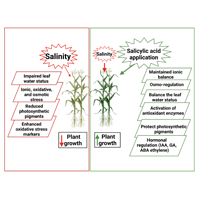Improved salinity tolerance in early growth stage of maize through salicylic acid foliar application

Accepted: 22 March 2021
Appendix: 93
HTML: 59
All claims expressed in this article are solely those of the authors and do not necessarily represent those of their affiliated organizations, or those of the publisher, the editors and the reviewers. Any product that may be evaluated in this article or claim that may be made by its manufacturer is not guaranteed or endorsed by the publisher.
Soil salinity threatens agricultural production worldwide by constraining plant growth and final crop yield. The early stages are most sensitive to salinity, in response to which salicylic acid (SA) has demonstrated beneficial effects in various plant species. Based on this, a maize (Zea mays L.) pot experiment was set up combining three levels of soil salinity (0, 6 and 12 dS m–1), obtained through NaCl addition, with three levels of SA (0, 300 and 600 mM), applied by leaf spraying 20 days after seedling emergence. Fifteen days later, the following traits were assessed: morphology (plant height, leaf number), growth (root and shoot dry weight), leaf water status [relative water content (RWC), electrolyte leakage (EL)], pigments (chlorophyll a and b, carotenoids, anthocyanin), antioxidant enzymes (peroxidase, catalase, ascorbate peroxidase, vitamin C), oxidative stress markers (H2O2, malondialdehyde), osmo-regulating compounds (free amino acids, soluble proteins and sugars, proline), hormones [indole-3-acetic acid, gibberellic acid (GA), abscisic acid (ABA), ethylene], element (Na, K, Ca, Mg and Cl) concentration and content in roots, stem and leaves. Salinity severely affected maize growth (–26% total dry weight), impaired leaf water status (–31% RWC), reduced photosynthetic pigments, enhanced all antioxidant enzymes and oxidative stress markers, two osmo-regulating compounds (soluble sugars and proline) out of four, and all hormones except GA. SA was shown effective in containing most of the stress effects, while supporting plant defences by upgrading antioxidant activities (reduced oxidative stress markers), increasing cell membrane stability (–24% EL) and leaf water status (+20% RWC), and reducing plant stress signalling (–10% ABA and -20% ethylene). Above all, SA contrasted the massive entry of noxious ions (Na+ and Cl–), in favour of K+, Ca2+ and Mg2+ accumulation. Lastly, salicylic acid was shown beneficial for maize growth and physiology also under non-saline condition, suggesting a potential use in normal field conditions.
Highlights
- Foliar applied salicylic acid alleviated salinity effects on maize growth at early plant stage.
- Salicylic acid improved leaf water status, chlorophyll content, and strengthened anti-oxidant enzymes under salinity.
- Salicylic acid reduced oxidative stress markers while enhancing osmo-regulating and hormonal responses to salinity.
- Salicylic acid hampered Na and Cl entry and translocation to above ground organs, preserving leaf cell membrane integrity.
- Salicylic acid was shown beneficial for maize growth and physiology also under non-saline conditions.
How to Cite

This work is licensed under a Creative Commons Attribution-NonCommercial 4.0 International License.
PAGEPress has chosen to apply the Creative Commons Attribution NonCommercial 4.0 International License (CC BY-NC 4.0) to all manuscripts to be published.

 https://doi.org/10.4081/ija.2021.1810
https://doi.org/10.4081/ija.2021.1810



